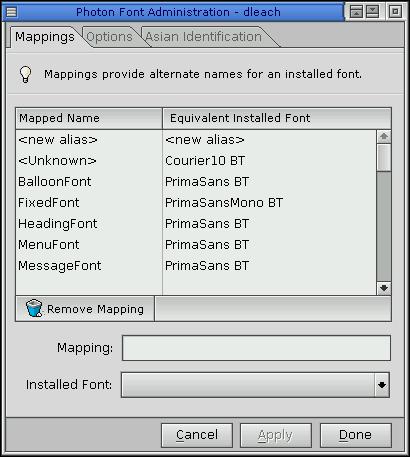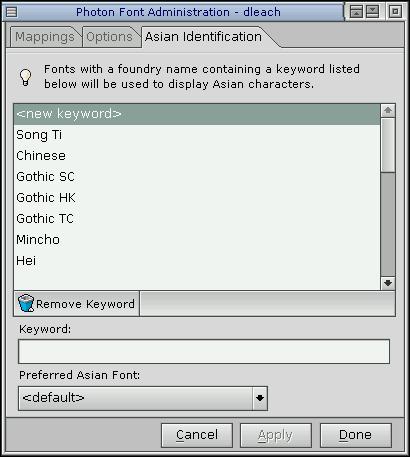![[Previous]](../prev.gif) |
![[Contents]](../contents.gif) |
![[Index]](../keyword_index.gif) |
![[Next]](../next.gif) |
![[Previous]](../prev.gif) |
![[Contents]](../contents.gif) |
![[Index]](../keyword_index.gif) |
![[Next]](../next.gif) |
 |
This version of this document is no longer maintained. For the latest documentation, see http://www.qnx.com/developers/docs. |
Font configuration utility
fontadmin [-c config_directory] [-d font_directory]
You can use the fontadmin utility to configure your fonts under Photon:
The fontadmin utility lets you specify mappings from one font name to another, which is useful if a certain font isn't installed. The Mappings panel looks like this:

You can also specify some options:

These options apply to all fonts:
Enabling this option may provide more uniform text output, but it significantly decreases performance.
Rendering plugin options are organized into schemas. A schema contains sections identified by a particular DLL identification name, and each section contains settings for that DLL.
By default, there is a server schema that applies to font server plugins. This schema contains all options for the font server, and cannot be removed, though the options can be modified. The server schema contains the same option values as default for the rendering plugins.
There is also an optional schema named dll which applies to font rendering DLLs that are run as local servers (see phfont and PfAttachLocalDll(). These sections only contain a cache size option which overrides the default option values. You can add additional options to these schemas.
Schemas are used by the following libfont API calls:
Schemas allow a client side application to invoke a private font instance with options tailored for the particular application.
To add a new schema, click on the + icon, then enter the schema name into a dialog.
To remove a schema, either click on the - icon, or click on the schema name to gain focus. Then right click on the schema name and select Remove Schema from the menu. To remove a schema, it must be empty of all sections and options.
To add a section to a schema, double click on the schema name. From the dialog that appears, select from the list of valid sections which may be added to the schema.
To remove a section, click on its section name to gain focus. Then right click on the section name, and select Remove Section from the menu.
 |
If you remove a section which contains options, the options are also removed. |
To add an option to a section, double click on the section name. From the dialog that appears, select an option from the list.
To remove an option, click on the option name to gain focus. Then right click on the option name, and select Remove Option from the menu.
To modify an option, double click on the option name. A dialog appropriate to the option is displayed.
 |
When modifying an option within the server schema, the changes are in real time. If you wish to undo any changes, you should revert to the previous value before selecting Done. |
The Asian Identification panel lets you identify and select the Asian font you prefer:

For example, if a font with the foundry name PrimaSans BT was installed, and a keyword of Prima existed, the font PrimaSans BT would be tagged by the font subsystem for use in Asian symbol lookup. This makes identifying Asian (CJK) symbols faster because the font subsystem needs to check only specified fonts instead of all installed fonts.
Using the Photon microGUI and Configuring Your Environment in the Neutrino User's Guide
![[Previous]](../prev.gif) |
![[Contents]](../contents.gif) |
![[Index]](../keyword_index.gif) |
![[Next]](../next.gif) |